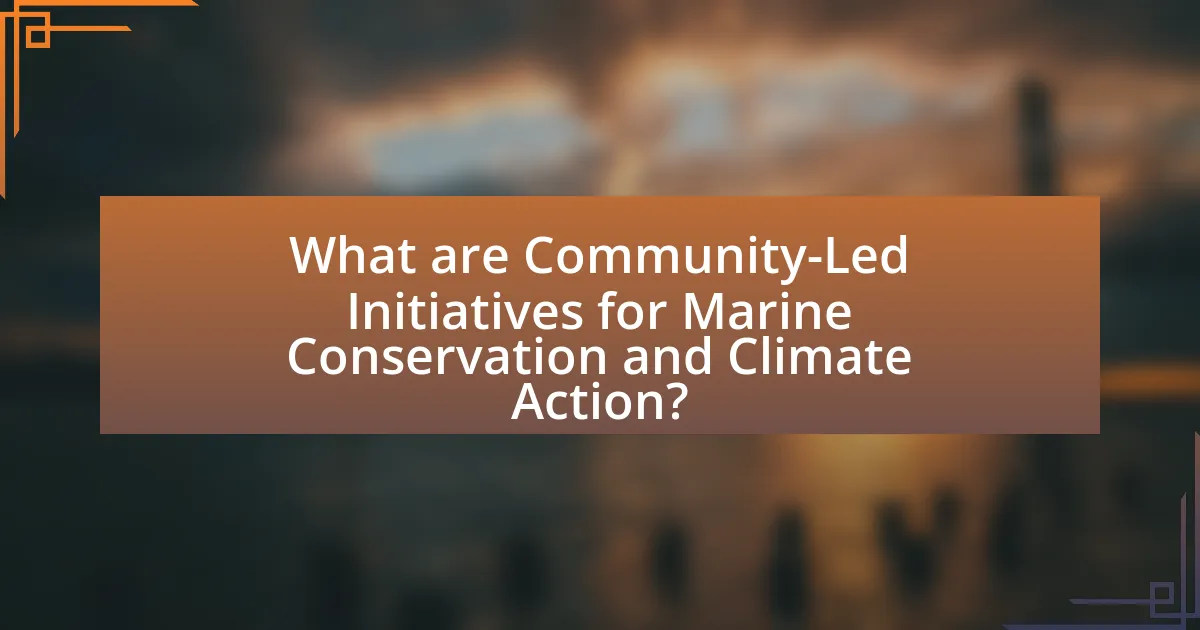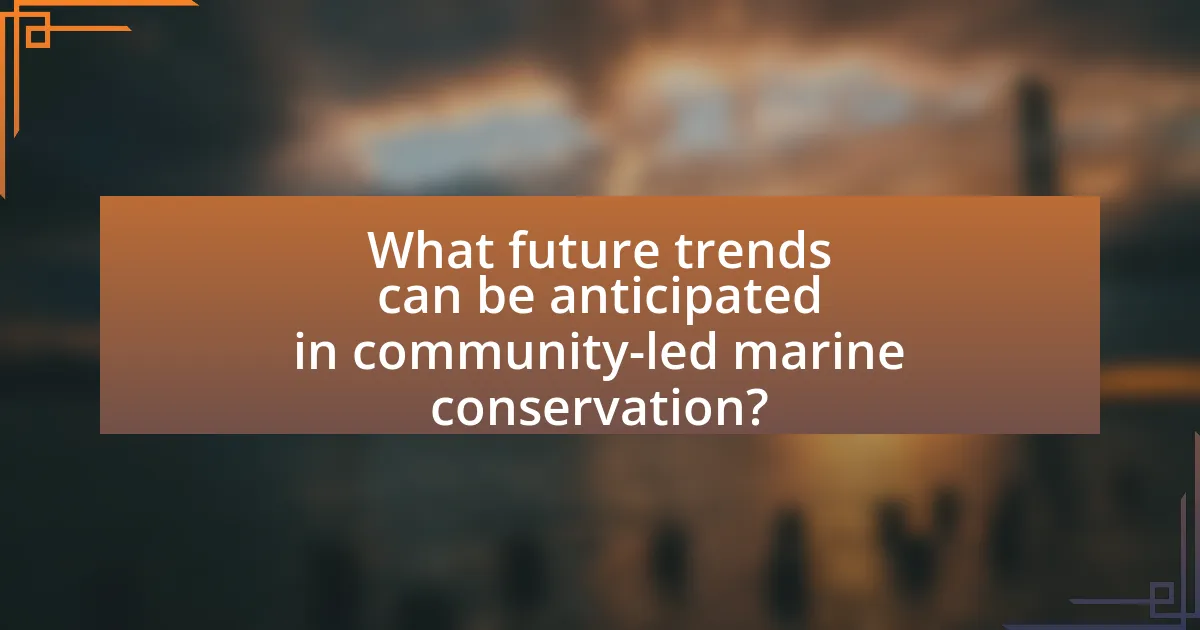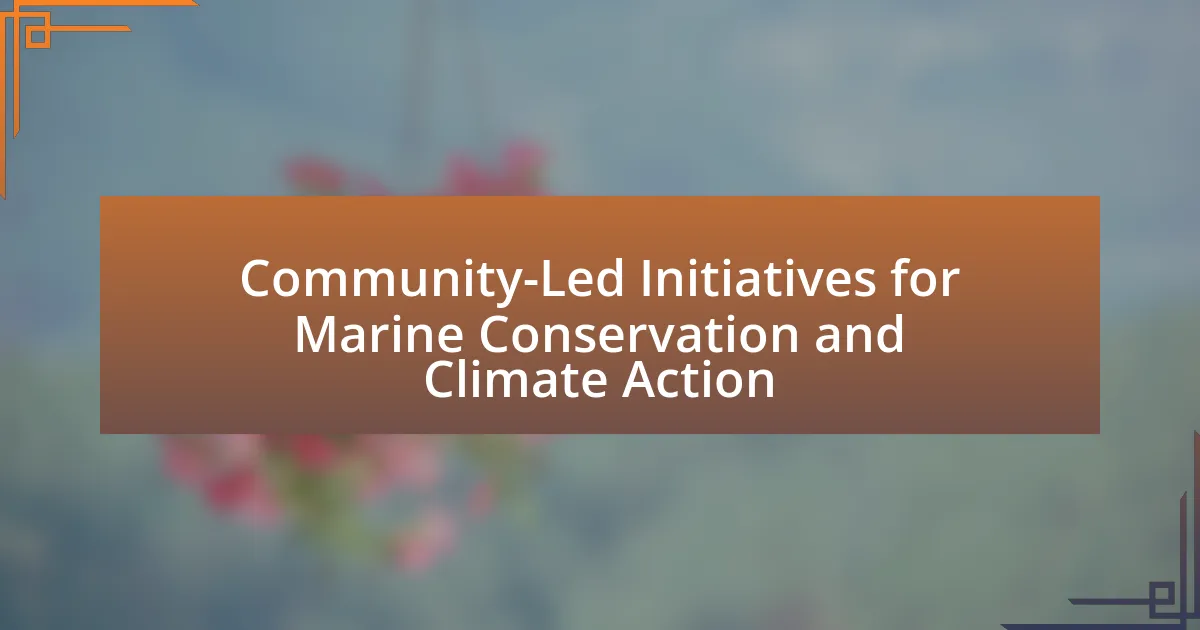Community-led initiatives for marine conservation and climate action are grassroots efforts where local populations actively engage in protecting marine ecosystems and addressing climate change. These initiatives involve collaboration among local stakeholders, including fishermen and indigenous groups, to implement sustainable practices, restore habitats, and promote awareness. Key actions include establishing marine protected areas, habitat restoration, and community education programs, which have been shown to enhance biodiversity and improve community resilience. Challenges such as limited funding and technical expertise exist, but successful examples demonstrate the effectiveness of local stewardship in achieving conservation goals and adapting to climate impacts. Future trends indicate a growing integration of technology and indigenous knowledge in these initiatives, further enhancing their sustainability and effectiveness.

What are Community-Led Initiatives for Marine Conservation and Climate Action?
Community-led initiatives for marine conservation and climate action are grassroots efforts where local communities actively engage in protecting marine ecosystems and addressing climate change impacts. These initiatives often involve local stakeholders, such as fishermen, indigenous groups, and environmental organizations, collaborating to implement sustainable practices, restore habitats, and promote awareness about marine conservation. For instance, the Coral Triangle Initiative, which involves countries like Indonesia and the Philippines, showcases how local communities can effectively manage marine resources while enhancing resilience to climate change. Such initiatives have been shown to improve biodiversity and increase community resilience, as evidenced by studies indicating that locally managed marine areas can lead to a 30% increase in fish biomass compared to unregulated areas.
How do these initiatives contribute to marine conservation?
Community-led initiatives contribute to marine conservation by empowering local populations to actively manage and protect their marine resources. These initiatives often involve the establishment of marine protected areas (MPAs), which have been shown to increase biodiversity and fish populations; for example, a study published in the journal “Nature” found that MPAs can lead to a 20-50% increase in fish biomass within their boundaries. Additionally, community engagement fosters sustainable fishing practices and reduces overfishing, as local stakeholders are more likely to adhere to regulations they helped create. This participatory approach not only enhances ecological resilience but also supports the livelihoods of communities dependent on marine resources, creating a sustainable balance between conservation and economic needs.
What specific actions are taken in these initiatives?
Community-led initiatives for marine conservation and climate action typically involve actions such as habitat restoration, sustainable fishing practices, and community education programs. Habitat restoration includes activities like replanting mangroves and coral reefs, which enhance biodiversity and protect coastlines. Sustainable fishing practices are promoted through the establishment of marine protected areas and the implementation of catch limits to prevent overfishing. Community education programs aim to raise awareness about marine ecosystems and climate change impacts, fostering local stewardship and engagement in conservation efforts. These actions are supported by various studies showing that community involvement significantly improves conservation outcomes and resilience against climate change.
How do these actions impact local marine ecosystems?
Community-led initiatives for marine conservation and climate action positively impact local marine ecosystems by enhancing biodiversity and improving habitat quality. These actions often involve local communities in sustainable fishing practices, habitat restoration, and pollution reduction, which collectively contribute to healthier marine environments. For instance, a study published in the journal “Marine Policy” found that community-managed marine protected areas can lead to a 30% increase in fish biomass compared to unprotected areas, demonstrating the effectiveness of local stewardship in fostering marine life.
Why are community-led initiatives important for climate action?
Community-led initiatives are crucial for climate action because they empower local populations to take ownership of environmental issues and implement tailored solutions. These initiatives often leverage local knowledge and resources, resulting in more effective and sustainable practices. For instance, a study published in the journal “Nature Sustainability” found that community-driven conservation efforts can lead to a 30% increase in biodiversity and improved ecosystem resilience. This demonstrates that when communities are actively involved, they can significantly enhance climate adaptation and mitigation efforts.
What role do local communities play in climate resilience?
Local communities play a crucial role in climate resilience by implementing adaptive strategies that enhance their ability to withstand climate impacts. These communities often possess traditional ecological knowledge, which informs sustainable practices and resource management tailored to local conditions. For instance, community-led initiatives in coastal areas, such as mangrove restoration, have been shown to reduce vulnerability to storm surges and erosion, thereby protecting both ecosystems and human settlements. Research indicates that areas with strong community engagement in conservation efforts experience better ecological outcomes and increased resilience to climate change, as evidenced by studies from the International Union for Conservation of Nature, which highlight the effectiveness of local stewardship in enhancing biodiversity and ecosystem services.
How do these initiatives address climate change effects on marine environments?
Community-led initiatives address climate change effects on marine environments by promoting sustainable practices that enhance ecosystem resilience. These initiatives often involve local communities in conservation efforts, such as restoring mangroves and coral reefs, which serve as natural barriers against climate impacts like rising sea levels and increased storm intensity. For instance, a study published in the journal “Nature” highlights that mangrove restoration can reduce coastal erosion by up to 70%, thereby protecting marine habitats and communities from climate-related damage. Additionally, these initiatives often include education and advocacy components that empower communities to adopt sustainable fishing practices, reducing overfishing and allowing marine populations to recover, which is crucial for maintaining biodiversity in the face of climate change.
What challenges do community-led initiatives face?
Community-led initiatives face several challenges, including limited funding, lack of technical expertise, and insufficient community engagement. Limited funding restricts the ability to implement and sustain projects, as many initiatives rely on grants or donations that may not be consistent. A lack of technical expertise can hinder the effectiveness of conservation efforts, as community members may not have the necessary skills or knowledge to address complex environmental issues. Additionally, insufficient community engagement can lead to a lack of support or participation, which is crucial for the success of these initiatives. Research indicates that successful community-led projects often require strong local leadership and collaboration with external experts to overcome these barriers.
What are the common obstacles to implementation?
Common obstacles to implementation in community-led initiatives for marine conservation and climate action include lack of funding, insufficient stakeholder engagement, and inadequate technical expertise. Lack of funding often hinders the ability to launch and sustain projects, as financial resources are critical for operational costs and outreach efforts. Insufficient stakeholder engagement can lead to resistance or apathy from community members, undermining the initiative’s effectiveness. Inadequate technical expertise may result in poorly designed projects that fail to meet conservation goals, as communities may lack access to necessary knowledge or training. These obstacles are frequently cited in studies on community-led conservation efforts, highlighting the need for comprehensive support systems to address these challenges.
How can communities overcome these challenges?
Communities can overcome challenges in marine conservation and climate action by implementing collaborative strategies that engage local stakeholders. These strategies include establishing community-led conservation programs, promoting sustainable fishing practices, and enhancing education and awareness about marine ecosystems. For instance, the Coral Triangle Initiative, which involves multiple countries, demonstrates how collaborative efforts can lead to effective marine resource management and biodiversity conservation. Additionally, research shows that communities actively participating in decision-making processes are more likely to adopt sustainable practices, as evidenced by the success of community-managed marine protected areas in places like the Philippines, where local governance has led to improved fish stocks and ecosystem health.
How can community-led initiatives be effectively supported?
Community-led initiatives can be effectively supported by providing access to funding, resources, and training tailored to local needs. Financial support can come from grants, partnerships with NGOs, or government programs that prioritize community engagement in marine conservation and climate action. Additionally, offering resources such as educational materials and tools can empower communities to implement their initiatives successfully. Training workshops can enhance skills in project management, sustainable practices, and advocacy, ensuring that community members are equipped to lead their efforts. Research indicates that initiatives with strong local involvement and adequate support have a higher success rate, as seen in the case of the Coral Triangle Initiative, which emphasizes local governance and community participation in marine resource management.
What resources are essential for successful initiatives?
Essential resources for successful community-led initiatives in marine conservation and climate action include funding, skilled personnel, community engagement, and access to scientific data. Funding is critical as it supports project implementation and sustainability; for instance, the Ocean Conservancy reports that financial backing enables communities to develop effective conservation strategies. Skilled personnel, such as marine biologists and environmental educators, provide the expertise necessary for informed decision-making and capacity building. Community engagement fosters local ownership and participation, which are vital for the long-term success of initiatives, as evidenced by the success of the Coral Triangle Initiative, where local involvement significantly improved conservation outcomes. Access to scientific data ensures that initiatives are based on sound research, allowing for adaptive management and informed policy-making, as highlighted by the Global Environment Facility’s emphasis on data-driven approaches in environmental projects.
How can partnerships enhance the effectiveness of these initiatives?
Partnerships can enhance the effectiveness of community-led initiatives for marine conservation and climate action by leveraging diverse resources, expertise, and networks. Collaborative efforts among local communities, NGOs, government agencies, and academic institutions can lead to more comprehensive strategies that address complex environmental challenges. For instance, partnerships can facilitate knowledge sharing, enabling communities to adopt best practices and innovative solutions tailored to their specific contexts. Additionally, joint funding opportunities can increase financial support for initiatives, allowing for larger-scale projects and sustained impact. Evidence shows that initiatives involving multiple stakeholders often achieve higher success rates, as seen in the Coral Triangle Initiative, which brought together six countries to improve marine resource management, resulting in enhanced biodiversity and community resilience.

What are the key examples of successful community-led initiatives?
Key examples of successful community-led initiatives in marine conservation and climate action include the Coral Triangle Initiative, which involves six countries collaborating to protect marine biodiversity, and the community-managed marine areas in Fiji, where local communities have successfully restored fish populations and habitats. The Coral Triangle Initiative has led to the establishment of marine protected areas covering over 5 million square kilometers, demonstrating effective regional cooperation. In Fiji, community-led efforts have resulted in a 30% increase in fish biomass within protected zones, showcasing the impact of local stewardship on marine ecosystems.
How have specific communities implemented marine conservation projects?
Specific communities have implemented marine conservation projects through collaborative efforts that involve local stakeholders, education, and sustainable practices. For example, the coastal communities in the Philippines have established marine protected areas (MPAs) to conserve biodiversity and enhance fish stocks. These MPAs are managed by local fishers who enforce regulations, ensuring sustainable fishing practices and protecting critical habitats. Evidence of success includes a reported increase in fish populations and biodiversity within these protected zones, demonstrating the effectiveness of community-led initiatives in marine conservation.
What lessons can be learned from these successful projects?
Successful projects in community-led initiatives for marine conservation and climate action demonstrate the importance of local engagement and collaboration. These projects show that involving community members in decision-making processes leads to more sustainable outcomes, as local knowledge and vested interests drive commitment and action. For instance, the success of the Coral Triangle Initiative, which involves multiple countries and local communities, highlights how shared responsibility and cooperation can enhance marine biodiversity conservation. Additionally, these projects reveal that education and awareness-raising are crucial; communities that understand the ecological and economic benefits of conservation are more likely to participate actively. Evidence from the Blue Ventures project in Madagascar indicates that when communities are empowered with knowledge and resources, they can effectively manage marine resources, leading to improved livelihoods and ecosystem health.
How do these examples inspire other communities?
Community-led initiatives for marine conservation and climate action inspire other communities by demonstrating effective, localized solutions to environmental challenges. These examples showcase how grassroots efforts can lead to significant ecological improvements, such as the restoration of coral reefs or the reduction of plastic waste, which encourages similar actions in other regions. For instance, the success of community-managed marine protected areas in places like the Philippines has led to increased fish populations and biodiversity, prompting neighboring communities to adopt similar management practices. This ripple effect illustrates the power of shared knowledge and collaboration, motivating other communities to engage in sustainable practices that address climate change and marine conservation.
What innovative approaches are being used in these initiatives?
Innovative approaches in community-led initiatives for marine conservation and climate action include the use of technology for data collection and monitoring, such as mobile applications that enable local communities to report environmental changes in real-time. These initiatives often employ participatory mapping techniques, allowing communities to visualize and manage their marine resources effectively. Additionally, they incorporate educational programs that empower local populations with knowledge about sustainable practices and the importance of biodiversity. Evidence of effectiveness can be seen in projects like the Coral Triangle Initiative, which has successfully engaged local communities in conservation efforts, leading to improved marine biodiversity and resilience against climate change.
How does technology play a role in community-led marine conservation?
Technology significantly enhances community-led marine conservation by providing tools for data collection, monitoring, and communication. For instance, mobile applications enable local communities to report illegal fishing activities and track marine biodiversity, fostering real-time data sharing. Additionally, satellite imagery and drones assist in mapping marine habitats and assessing environmental changes, which empowers communities to make informed decisions about conservation strategies. Studies have shown that communities utilizing technology for monitoring can increase compliance with conservation regulations by up to 30%, demonstrating the effectiveness of these tools in promoting sustainable practices.
What unique strategies have emerged from grassroots movements?
Unique strategies that have emerged from grassroots movements in the context of community-led initiatives for marine conservation and climate action include localized advocacy, community education programs, and collaborative resource management. Localized advocacy focuses on mobilizing community members to influence policy decisions that directly affect their marine environments, as seen in the success of the Coastal Communities Network in the UK, which empowered local voices to shape marine policy. Community education programs, such as those implemented by the Ocean Conservancy, aim to raise awareness about marine issues and promote sustainable practices among residents, leading to increased community engagement and stewardship. Collaborative resource management strategies, exemplified by the establishment of community-managed marine protected areas in places like the Philippines, demonstrate how local stakeholders can effectively manage and protect marine resources through collective action and shared governance. These strategies highlight the effectiveness of grassroots movements in fostering sustainable practices and influencing environmental policy at the local level.

What future trends can be anticipated in community-led marine conservation?
Future trends in community-led marine conservation include increased integration of technology, enhanced collaboration with local governments, and a focus on indigenous knowledge. The use of technology, such as drones and mobile applications, will facilitate real-time monitoring of marine ecosystems, allowing communities to respond swiftly to environmental changes. Collaboration with local governments will strengthen policy frameworks that support community initiatives, as seen in successful models like the Philippines’ community-managed marine protected areas. Additionally, incorporating indigenous knowledge will empower local communities to implement sustainable practices that have been effective for generations, as evidenced by the resurgence of traditional fishing methods in various coastal regions. These trends indicate a shift towards more inclusive and adaptive conservation strategies that leverage local expertise and resources.
How is climate change influencing the direction of these initiatives?
Climate change is significantly influencing the direction of community-led initiatives for marine conservation and climate action by necessitating adaptive strategies that address rising sea levels, ocean acidification, and biodiversity loss. These initiatives are increasingly focused on enhancing resilience in marine ecosystems, promoting sustainable fishing practices, and restoring habitats to mitigate the impacts of climate change. For instance, a study published in the journal “Marine Policy” highlights that communities are prioritizing the establishment of marine protected areas to safeguard biodiversity and improve ecosystem services, which are critical under changing climate conditions. This shift reflects a growing recognition of the interconnectedness of climate health and marine conservation efforts.
What emerging practices are communities adopting to adapt to climate impacts?
Communities are adopting practices such as ecosystem restoration, sustainable agriculture, and community-based resource management to adapt to climate impacts. For instance, coastal communities are implementing mangrove restoration projects to enhance natural barriers against storm surges and erosion, which has been shown to reduce vulnerability to extreme weather events. Additionally, sustainable agricultural practices, including crop diversification and agroforestry, are being utilized to improve food security and resilience against changing climate conditions. These practices are supported by research indicating that community-led initiatives can effectively mitigate climate risks while promoting biodiversity and sustainable livelihoods.
How can future initiatives be designed to be more sustainable?
Future initiatives can be designed to be more sustainable by integrating community engagement and local knowledge into their planning and execution. This approach ensures that initiatives are tailored to the specific environmental and social contexts of the communities involved, leading to more effective and lasting outcomes. For example, research shows that community-led conservation efforts, such as those documented in the “State of the World’s Fisheries and Aquaculture” report by the Food and Agriculture Organization, have led to improved biodiversity and resource management. By prioritizing local participation, initiatives can leverage indigenous practices and foster a sense of ownership, which is crucial for long-term sustainability.
What practical steps can communities take to initiate their own marine conservation efforts?
Communities can initiate their own marine conservation efforts by forming local conservation groups to assess and address specific marine issues. These groups can conduct community workshops to raise awareness about marine ecosystems and the importance of conservation. Additionally, communities can collaborate with local governments to establish marine protected areas, which have been shown to enhance biodiversity and fish populations. Engaging in clean-up activities along coastlines and organizing educational programs in schools can further foster a culture of conservation. Research indicates that community-led initiatives, such as the establishment of the Great Barrier Reef Marine Park, have successfully improved marine health and biodiversity, demonstrating the effectiveness of local action in marine conservation.
What resources are available for communities to start their initiatives?
Communities can access various resources to start their initiatives in marine conservation and climate action, including funding opportunities, educational materials, and partnership networks. Funding sources such as grants from environmental organizations, government programs, and crowdfunding platforms provide financial support for projects. Educational resources, including workshops, online courses, and toolkits from organizations like the Ocean Conservancy and the National Oceanic and Atmospheric Administration, equip communities with knowledge and skills. Additionally, partnership networks, such as local NGOs and community groups, foster collaboration and share best practices, enhancing the effectiveness of initiatives.
How can communities engage stakeholders effectively in their efforts?
Communities can engage stakeholders effectively by fostering inclusive dialogue and collaboration. This involves organizing regular meetings and workshops that invite diverse stakeholder participation, ensuring that all voices are heard and valued. Research indicates that inclusive stakeholder engagement leads to better decision-making and increased trust, as seen in the case of the Coastal and Marine Ecosystems Program, which successfully involved local fishermen, conservationists, and government agencies in collaborative management efforts. By utilizing tools such as surveys and feedback mechanisms, communities can gather input and adapt their initiatives to meet stakeholder needs, thereby enhancing commitment and support for marine conservation and climate action efforts.
